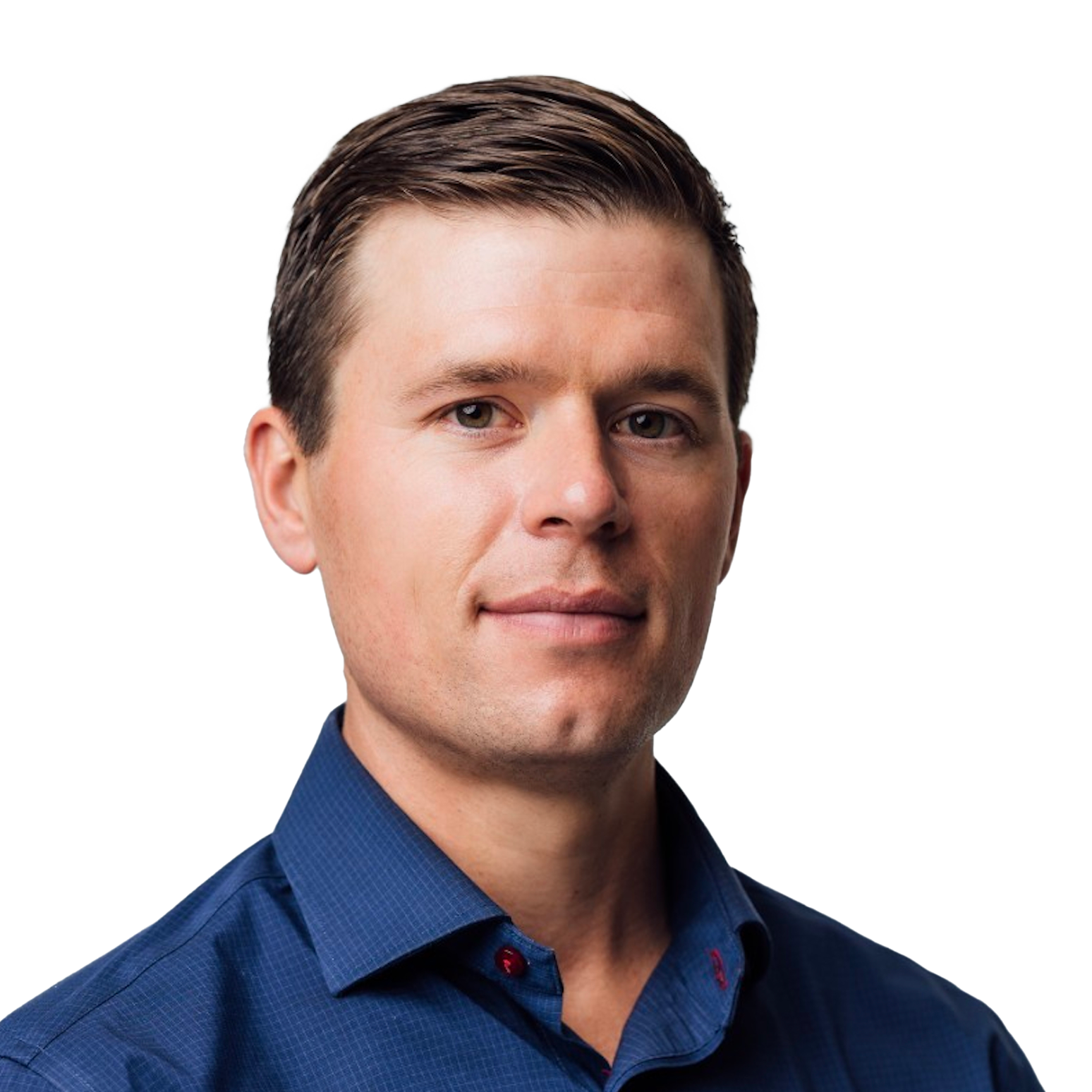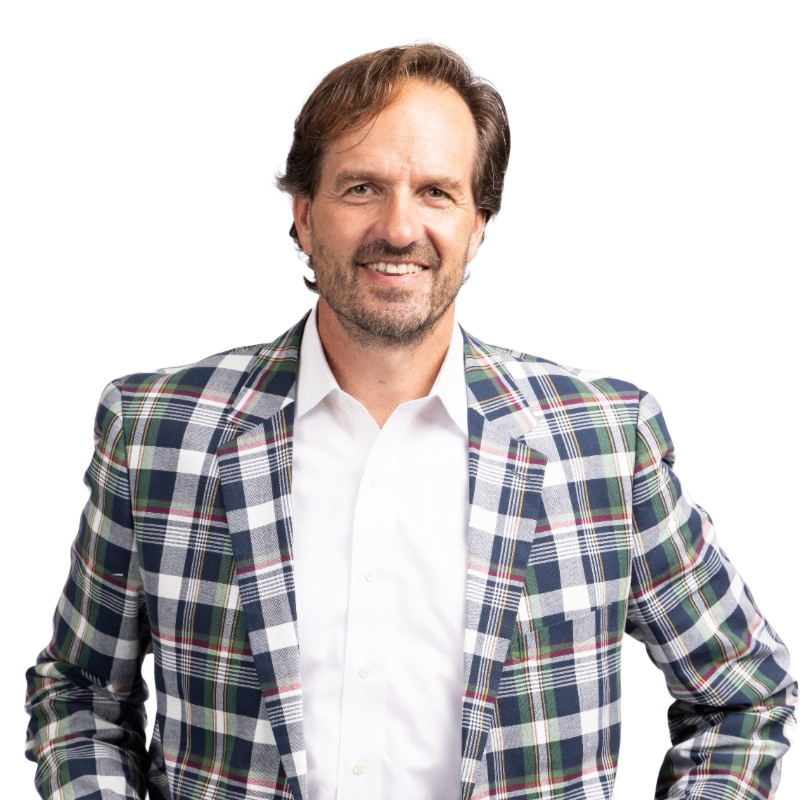
BACK TO PODCASTS
Kyle Coleman
Global VP Marketing
|
ClickUp
Episode #
32
In this episode, Kyle Coleman shares how resilience shaped his career and why AI should accelerate execution, not dictate strategy.

In this episode of Predictable Growth, Kyle Coleman, Global VP of Marketing at ClickUp and former Clari and Looker leader, shares how resilience and adaptability have shaped his approach to leadership, sales, and marketing. He explains why AI should accelerate execution, not dictate strategy, and gives practical examples of how go-to-market teams can use AI tools to move faster, market more effectively, and stay focused on what truly drives growth.
Kyle also discusses how to build high-trust, high-efficiency teams. He reflects on leadership during change, parenting while leading, and how to create a sustainable work rhythm that keeps both performance and presence in focus.
Highlights
- How Kyle Coleman’s journey from Looker to Clari to ClickUp shaped his GTM leadership style
- Why AI should empower execution, not define strategy
- Practical ways sales and marketing teams can use AI to move faster and market the problem
- How to build trust and alignment in fast-changing organizations
- Balancing leadership, parenting, and presence
Podcast Transcript
Topics & Chapters
- 00:00 Cold open: AI isn’t your strategy
- 00:27 Intro & Kyle’s background
- 02:11 Resilience from mom; embracing hard problems
- 04:03 Creativity, iteration, and no silver bullets in marketing
- 05:25 What ClickUp is: the converged workspace vision
- 07:28 ClickUp as SMB-friendly CRM & flexible platform
- 09:12 How AI changes campaigns & execution velocity
- 11:41 Don’t outsource strategy to AI; quality vs. volume
- 14:39 Sales: AI handles routine, humans connect strategy
- 16:08 Careers: be an AI native; show your POV and workflows
- 19:02 Process thinking: automate segments, save hours
- 20:26 Engineering gains; judgment still required
- 21:39 Weekly AI-use-case ritual; lead scoring example
- 24:18 Removing stigma around using AI
- 25:39 Culture: trust, autonomy, accountability, high standards
- 28:20 Decide with 80% info; iterate
- 28:49 Looker & Clari: market the problem, then the solution
- 32:12 Team stages; generalists → specialists
- 33:31 Hiring signals for curiosity
- 35:33 Performers vs. durable operators
- 37:07 Career advice: run toward the fire
- 39:59 Parenting, presence, and east-coast schedule
- 41:50 Close
Raw transcript
Tracy (0:27): Hi. Welcome to path to growth. I’m Tracy young, co founder of Tiger eye. Today
we are joined by Kyle Coleman, global, VP of Marketing at clickup. Kyle, welcome.
Kyle: Hello, Tracy. How you doing? Thanks for joining us today.
Tracy: So to start, tell me about growing up in Rhode Island, tell us about mom and dad and what you learned from them.
Kyle (0:47): Oh, my dad was in the Navy, so I grew up kind of all over the place. I was
actually born in Hawaii, and then moved to Italy for a little while, where my little brother
was born, and then he got stationed, or re stationed, in Rhode Island, which is where I grew
up, and it’s a great place to live. I recently just moved back here, so I was on the west
coast for a little while, and then I was in Colorado, and then I had a son of my own. And my
wife and I are both from here, and her family is all rooted here, and having that support
network for a year and a half old son is really helpful. So we’ve been back here for about a
month now, and so far so good. It’s it’s a nice place to live,
Tracy (1:25): yeah, and you know, as a working professional and parent, it’s so important to
have the multi generational family where the grandparents and the aunties and uncles and
cousins are in the children’s lives. So I’m really happy for you guys.
Kyle (1:41): It makes a big difference, and it makes me really have a different level of
appreciation. I thought I appreciated what my mom did raising three sons without any of that
social network or family network, and now I know, or I feel like I have a much better
appreciation for it. It’s like borderline superhero territory, to be able to do all that stuff
alone. It’s really pretty.
Tracy (2:06): remarkable. Tell me about what you learned from mom.
Kyle (2:11): God, that’s a that’s a tough question, as the list is very long, I would say the
main thing is resilience. It’s the main thing, and I think it’s really an important thing,
especially as I started my career in sales. You know, if you’re only failing 99% of the time
in sales, you’re doing something right. It’s crazy. And if you don’t have that thick skin, and
you don’t have that resilience, and you don’t have that confidence in yourself, not
necessarily to get something right the first time you do it, but to have the confidence that
you’re going to learn and be able to do something well, that, I think, is something that I
learned from my mom, just like jump in, run toward the fire, try and figure something out, and
the journey of solving a problem is the most interesting part of life, and that’s a big
lesson. I owe a lot of my career development to that kind of mindset
Tracy (2:56): and resilience is so important. I’ve seen so many people, really talented, smart people who
have just been unable to deal with failure, and then who just gave up the first time they
failed in their lives and just couldn’t find that resiliency so 100%
Kyle (3:13): and as what I always tell people, especially people that are earlier in their
careers, is, looking back on my career, I don’t remember the easy stuff. Tracy, it’s not like
I remember the thing that you solve in an hour and you move on. You remember the stuff that is
hard. It’s the stuff that took you days or weeks or months sometimes to get right, or the
thing that you put in maximum effort and it was a total dud and you had to rebuild from the
ground up. Like, those are the types of things that you really remember. So I feel like many
people have this aversion to hard work, or they feel like if something is hard, it’s a failure
because it’s hard. And I try and make sure that people understand that that’s no way to live
life, and certainly no way to grow your career. So that resilience, I think, is really
important thing that seems to be somewhat absent from the way that a lot of people approach
their work,
Tracy (4:03): it’s so true, especially in marketing, where there’s never a silver bullet, at
least I haven’t found one, right? It’s not like I can just spend money on this one thing and
I’m going to have all this pipeline. I’ve got to try a dozen things any given time just to get
enough pipeline to feed the sales team, and so much of it is just having the courage and
Audacity to be as creative as you can, and to try something new and to see if it works, and
then if it doesn’t, to just tweak it or try something completely different, and over and over
and over again,
Kyle (4:36): 100% and you know, there’s always, or not always, but often there’s some
opportunity for some arbitrage, for some channel that hasn’t been figured out or cracked by B
to B marketers. And so you can get in early, and you can sort of have a first mover advantage
on these things, but it always evaporates. And as soon as something starts to feel like a
silver bullet, that’s when everybody else figures it out, and then the advantage goes away. So
it’s a constant evolution, and to require. ROS equal parts creativity and analysis and a real
understanding of what are we doing that’s really measurable, what are we doing that’s really
repeatable? And how can I apply a creative process to that, to do it over and over and over
again in different forms, so that you stay fresh and you stay consistent, and you keep that
same brand promise, but you tell the story in different ways that compels an audience to take
action. That’s very hard nut to crack, so
Tracy (5:25): tell our audience what, what is click up.
Kyle (5:29): Click up is so have you ever used it before? Tracy, no, I haven’t. Ah, okay, so
click up, traditionally, is thought of as a productivity platform, and you’ll hear people talk
about task management, and you’ll hear people talk about project management, and all that
stuff is very important. And clickup has built a wonderful business on on that I joined four
months ago, and the way that I think about clickup is actually quite different, and forgive
me, because I’m going to go into a little bit of marketing speak right now, but I think it’s
important as I work this idea out in real time, clickup is a truly converged workspace. And
what I mean by that is, I kind of draw the distinction between bundles, or, like, suites of
applications before, like, the productivity suite that you get from Microsoft is word and it’s
Excel and it’s PowerPoint and it’s OneNote, it’s all those things, and they’re not really
connected. It’s a suite. It’s a bundle. You get a price discount when you buy all of them.
Great. Microsoft, 365, I have it all, and that’s been very useful. But what clickup is
offering is more of a converged workspace that is pulling together these previously distinct
work apps and truly intertwining them and integrating them so that your chat and your docs and
your projects and your forms and your whiteboards are all accessible by one another, learning
from one another, incorporated with one another, and then layered with AI that’s doing a lot
of the connective tissue. So clickup is this converged workspace that is everything that
people need to get work done, and most popularly used by project management pros or by
marketing pros. A lot of like it. Teams will use clickup for product launches and things like
that. Finance teams use it for RFP processes and contracting like the use cases are incredibly
horizontal, and it’s because of all of these various apps converging into one workspace that
makes them really usable,
Tracy (7:24): so businesses can really, truly run their business completely on clickup.
Kyle (7:28): Yes, it’s basically a lot of people will think about it Tracy as a development
platform for whatever use case you want to build. And something that was very surprising to
me, as I was researching clickup Before I joined, is how popular it is as a CRM in SMB
businesses. I just had never thought about it before, but then I thought about, well, what is
a CRM? Well, it’s a kind of this collection of tasks or ROS that have some Interplay or
relationship with one another. And of course, you can build that using clickup, and you can
have all the context right there and all the docs right there. And so it makes a lot of sense
that instead of spending however much you would spend on a HubSpot or Salesforce or whatever
deployment, you can do this kind of in an ad hoc way, using clickup, and we’re starting to see
so many incredible use cases just because of the development that you can do on top of the
platform. And then, as I mentioned before, that confluence of all these apps that then has
compounding value, right?
Tracy (8:23): So it sounds like there’s a lot of flexibility for customers to customize this
to their workflow and needs exactly right as an SMB, like, you’re not turning on Salesforce. I
mean, at least you shouldn’t have any higher team of people to configure it and then, like,
administer
Kyle (8:39): it. That’s right. And HubSpot is better in this respect. But even still, there’s,
there’s a lot of price sensitivity, and if you can build something yourself, you that’s a hell
of a lot better than a spreadsheet like use clickup for it. You’re if you’re using clickup
already for much of your task management, project management, or documentation, or a lot of
people use clickups Chat instead of using Slack. So if you’re already using clickup. Then try
out the CRM. We have a template. You can go and install that template in literally 10 seconds,
and now you’re off and running with a CRM that’s perfect for for SMB and mom and pops.
Tracy (9:12): So you’ve led marketing at several high growth companies. How has AI tangibly
changed the way teams operate today versus just a few years
Kyle (9:22): ago? Yeah, it’s it’s about speed of execution for me, Tracy specifically around.
Let’s just use campaigns as an example. Because campaigns are cross functional, they’re multi
discipline, they’re creative, they’re analytical, they’re basically all the things from your
marketing strategy to your creative deployment, your content, your demand generation,
marketing ops, and then your sales team. And in the past, executing a campaign was quite a
required a lot of orchestration, and there was a lot of planning that went into it, and
there’s a lot of hand holding that goes into it, and then there’s a lot of like, bottlenecks
that end up happening, and getting any campaign out the door is really difficult. So. Now with
AI, what’s been really amazing to me is how much friction you can remove from that process. So
I’ll give you like the easiest example is when you’re planning a campaign, often you’re going
to have whoever, four or five people in the room, and you’re talking about, what are the goals
here, what is the audience, what’s the main messaging, and all the rest. And then somebody
takes that meeting and three, four or five days later, comes back with the campaign brief. Now
you have that Live Meeting. Ai takes that transcript and creates a campaign brief in literally
30 seconds, and you can go and start executing immediately, instead of having to wait however
many days it used to take a person to turn that around. Now, of course, that campaign brief
needs to be reviewed by a human, and a is not going to be perfect. It’s going to miss some
things, and your Live Meeting probably didn’t cover every angle, but the time that it takes to
execute is compressed from however many days to however many hours, and you can find an
opportunity for that kind of time savings and compression basically everywhere across the
marketing engine. In the
Unknown (10:56): last few months, I was able
Tracy (10:58): to meet with, well, several public company CEOs, but two of them specifically
told me the same thing, that their plan was to double revenue and bookings in the next few
years without increasing their team. So they plan on having the team stay the same size, but
double their business. And they really believed that they would be able to do that with AI.
What’s your take on it? You know, you are a marketing leader. You’ve got, I’m sure, demand gen
folks and product marketing folks and Field Marketing, etc, etc, etc. And you know, you’re
talking about the productivity increase by leveraging AI. How do you think about, like,
growing your
Unknown (11:39): team with the use of
Kyle (11:41): AI, I think it’s absolutely possible to achieve that outcome that those CEOs are
talking about increasing growth, increasing top line, increasing productivity, without
significantly increasing your head count. The mistake, though, is thinking that AI is a
solution for your strategy, and if you try and outsource your strategy to AI to come up with a
creative marketing campaign, or to come up with new, original thinking, or to come up with
some way of like, it’s just not that’s not how these llms function. They are literally trained
on the past. They cannot invent the future. And good marketing invents the future and gives
your target audience a vision of where they need to be, and creates a visceral pain around the
status quo, and then offers a unique solution that’s your product or solution or technology or
whatever, that gets people from this current painful existence to this new existence. I’ve
seen companies or people try and run their entire marketing department with AI, and the
outcome of that is always very bland, and yeah, they’ll get a million SEO optimized blog
posts, and yeah, they’ll get a million different ad variants that’ll perform okay on social or
whatever. But if there’s no real meat or no real wood behind the arrow, and there’s no real
creative marketing strategy, and there’s no real visceral pain point, and your human sellers
are unable to actually sell against any of that vision. You’re creating a lot of work and
potentially creating a pipeline that’s never going to go anywhere. So long way of saying, yes,
outsource what you can to AI, but don’t outsource strategy. You need to find the people who
have the right balance of being strategic thinkers that can connect the dots and being really
good operators, who know what good looks like and can measure and perform. And if you find one
of those people, they can do five times, 10 times, what a person could have done two years ago
with the new technology that we have.
Unknown (13:40): Yeah, it’s so
Tracy (13:41): fascinating, even in the market that we serve, which is all the analyst and rev
ops and marketing ops folks that use our product and also C suite, of course, but it’s really
the people who are munching numbers on spreadsheet that Tiger I can we can just do that work
for you. But what we’re seeing is that there’s just this widening gap between the really good
analysts and ROS ops analysts and sales ops and marketing ops analysts, and then the mediocre
ones. Yes, AI can do a lot of their work in seconds. But what we can replace, and not nor that
we are aiming for, is replacing the strategy behind what to do next, like we can provide all
the insights we can provide you with any any trend line analysis and historical performance
review, and we can, of course, make suggestions. But at the end of the day, it’s going to take
real leadership with an L and real tactics and real execution that requires humans to
Kyle (14:39): execute on 100% sales is the same way AI is going to come and replace what
mediocre sales reps were doing. What are mediocre sales reps doing? They’re doing the lazy
stuff. They’re doing. They’re collecting the low hanging fruit. They’re doing the things that
will get them to 60% of their number, like monitoring product usage signals and then actioning
those signals and getting that small upsell. Hey, you’re using. 100 licenses. You’re only
contracted for 90. We need to go sell you 10 more licenses. That stuff is totally replaceable
by AI. What the best sales reps are doing is they’re connecting the dots. Why are they using
those licenses? What other behaviors have we seen? What can I find about their CEO posting on
LinkedIn that’s going to indicate some strategic initiative that that company has. How can I
connect this over utilization with that strategic initiative and go and actually sell
something that’s tops down? How can I layer my solution into their corporate planning so that
I can command more value and be a trust consultant to this company like those are the types of
A’s that are going to do really well. And of course, AI can help with the signal monitoring
type stuff, but the human connecting the dots is still so important. And you’ll see this
proxy, a proxy for this kind of like that mediocre person versus the superstar person,
replicated over and over and over again. And my hope and my contention and sort of my AI
optimism is that AI is going to help create more of these superstars. It’s just going to take
a little time for people to figure out what great looks like, because it’s not something we’ve
really had time or energy to train against. Before, I gave
Tracy (16:08): a talk at a go to market conference recently, and we did a Q and A session
afterwards, and I talked about, basically the punchline in my talk was, AI is not going to
replace people, but people using AI is going to replace people who don’t. That’s the bottom
line. You’ve got to figure out how to use AI to supercharge your skills and deliver much more
for the company, because you have this tool now. And when the Q and A questions came up,
there’s a lot of marketers that raise their hand, and there is obviously a lot of fear saying,
you know that that sounds great and all. It’s just that I’ve got a lot of marketing friends
that are on LinkedIn who’ve been looking for work and they’ve been unemployed for months now,
right? These are experienced marketers. What is your advice to I don’t know, folks in
marketing, folks in sales, like, what skill sets should they continue developing in this new
age
Kyle (16:59): of AI, yeah, yeah. And I definitely have empathy for those people, like, getting
a job is never, never easy about but what I have experienced as we’ve been hiring people
across the marketing team here and demand team and marketing ops teams and SDR teams is the
exact paradigm that you just mentioned. Tracy, I have interviews with people, and I asked them
what their perspective is on how they will incorporate AI into their day to day, and if they
don’t have a perspective on it, that’s a major red flag. And this is everybody, like, I meant
even SDR, individual SDRs that are fresh out of school sometimes have the best answer, because
they just spent the last three years in universities like figuring this stuff out. So I feel
like, if, if you’re not learning how to become an AI native, it’s the same exact thing as in
the late 90s, early 2000s if you just turned a blind eye to the internet, you’re like, ah, you
know, I don’t actually think I’m going to use that internet thing to do my work. People be
like, what do you what Come on? Or before that if, like, you’re not going to use a computer,
you’re not going to figure out how to use a spreadsheet and you’re just going to do all your
sums by hand in tables. It’s like, Why are you ignoring this technological wave that is
happening? So it is a mandate. It’s what companies are looking for. And the interesting thing,
and I mentioned this arbitrage moment, is companies don’t know what good AI deployments or
good AI employees look like. So you people that are on the job market, you can train them on
what good looks like. Here are the things that I have done to become super well versed in AI.
Here are the tools that I would need. Here are the workflows that I would impact. Here’s the
cost savings that I would bring. And you could have a very robust perspective on this. It’s
just a matter of exposure, and it’s a matter of you leaning in and the people that are doing
that and bringing that to the table proactively, they’re the ones that are getting through the
interview process. I basically guarantee it, because the output
Tracy (18:49): is the state same. I mean, the quality is the same. And if you can laser focus
on what were you doing before that, you can now trim to like, seconds and still have the same
output that’s incredibly powerful,
Kyle (19:02): 100% and so like and what that requires Tracy is you have to have a really
strong perspective on what good looks like. If you don’t have a good perspective on what good
looks like, then you can’t use AI to reach it like you need to know the destination in order
to draw the map. And I think that once people understand that everything that you do at work
is a process, you’re getting from A to Z somehow. And some of these processes lend themselves
to automation, and some of them don’t. The ones that do, you need to figure out how to codify.
You need to figure out how can I maybe fully A to Z. I can’t codify with AI, but I can
certainly get from a B to C using AI, and I just saved myself an hour. And you can do that for
all the different processes that you’re running, and sooner than later, you’re going to find
you’re saving yourself five hours a week, and then 10, and then 20, and then 40. It’s amazing
how much time you can end up saving yourself if you just really think critically about what
are all the. Things that I create, and what are the processes that I use to create them, and
where are their areas for automation? And once you start, once things start to click, this was
my experience anyway, Tracy, once I started thinking this way, and things started clicking for
me, and I started getting exposure to what AI couldn’t, couldn’t do it, unlocked everything
for me. And now another day, not an hour, goes by, where there isn’t some workflow that’s
powering what AI workflow that’s powering the work that I do?
Unknown (20:24): Yeah, and we’re seeing that over in Tiger
Tracy (20:26): eye engineering too. Our engineering leader just told me that AI has helped the
team increase productivity by about 25% that’s amazing. It’s probably going to grow over the
years. And of course, you can get AI to just give you a bunch of code, but it still takes
experience. Senior engineers, as you said earlier, with you’ve got to understand what good
looks like. Our senior engineers are looking at the, I don’t know, 1000 lines of code that AI
is dumping out, and they’ve got to be able to identify which parts are good and which parts
are bad, and what we’re going to actually jam into our code base. And what we found is it does
certain things really well, like unit testing code and then some things that just is kind of
bad at because the code is so complex. And I think the worst part is it almost looks right,
but there’s gonna it’s gonna introduce so many bugs and so again, it’s gonna take that senior,
experienced person to sort of sift through what is going to be valuable in our code base or
not. And I think the same thing is with go to market, and I’m so happy to hear that you guys
are leveraging AI to do a lot of your work. Can you give us one example of how your team has
implemented AI to save real time for them?
Kyle (21:39): So every week we have a mandate where every single employee on every Friday has
to submit at least one use case that they had for AI, big or small, big or small, like there’s
it could be the simplest thing that saved you 10 seconds, or it could be this crazy, complex
app that you built yourself that’s saving you two hours. I don’t care. I just want every
single Friday, everybody on the team to submit for full visibility across the whole team. Here
are the shortcuts that I found, and here are the ways that I’m using AI so we’ve gotten into
this cadence where there’s accountability from me. And I read all of these things, and I
respond to every single one every single week, because I care about this stuff. Like, if the
each individual member on the team isn’t becoming AI native, that means that our team is not
becoming AI native, and that means I’m failing as a leader. So there’s accountability from the
top that like, give your people license to be creative, and then give them accountability to
go and actually report on the things that are working for them. And as a result, my mind is
swimming through all of the 40 updates I get every single week on all the different AI use
cases that are out there, Tracy, but it’s things like for a marketing operations audience that
I think will find interesting is like lead scoring, lead scoring, traditional lead scoring is
pretty impresas, because you haven’t had really the data that you need to be able to do
something that’s really effective. But now with AI and all the unbelievable enrichment things
that you can do. We had our head of demand gen he created a lead scoring model that’s
leveraging a handful of different enrichment systems to get the full set of if somebody only
gives us their email address, how are we going to find out the 30 things we need about them to
build a profile that then scores them? But importantly, he also put together an AI system that
went through all the historical conversion data and applied this new scoring mechanism and
ensured that it was actually going to be predictive of future success. And he did it in an
hour. And that kind of thing used to take a marketing analyst, like a week, minimum, two
weeks, probably to do, and then, let alone, to implement the system, to actually get the lead
scoring system life, to be able to do all of that in an hour is absolutely remarkable. And
it’s like, that’s the kind of speed that you’re able to find. And that’s one of the more
complex use cases, of course, but it’s a very cool one, and that’s the type of thing that our
team is rooting out and inventing and inspiring everybody else to go and be like, Oh, I never
I didn’t know we had access to this system, or I didn’t know that AI could do this. I didn’t
know you could upload an image into the AI and it could read the image and tell you a Trend
Report. Like some people just don’t know. So a lot of it is about forcing exposure, and then
the use cases that you’ll get from the team have compounding value.
Tracy (24:18): Man, I am so happy to hear this, like tribal knowledge sharing and this
encouragement at your company and with your leadership. I read this report recently. I can’t
remember who published it, but most people are hiding the way they are using AI in fear of
like, the stigma behind it, and it’s
Unknown (24:38): just, you know,
Kyle (24:39): it feels like cheating. Sometimes it really does. And so sometimes you might be
a little reticent to share. Hey, you know, I wrote this. I Kyle wrote this LinkedIn post with
AI. All I did was jibber jabber into my talk to text feature using click up for three minutes,
and I said, turn this into a LinkedIn post. The style of Kyle, and it wrote the LinkedIn posts
like, it feels like cheating, because that used to take 30 minutes, 45 minutes, and now I just
did it in six it’s like, it’s crazy. And so I understand that people, you know, they are, they
are reticent, but what you have to realize is that you exposing your AI prowess is a means of
future proofing yourself. And I think most leaders at companies understand this, I could be
wrong, but most, I hope most leaders at companies understand this and are searching for the
employees that are leaning into this technology and valuing those people. So I hope that we
get we’re more open, and it’s there’s less of a stigma, because I understand that exists. But
man, it’s a mandate across our team.
Tracy (25:39): It’s great. How do you think about building team culture?
Kyle (25:43): For me, it’s a lot about trust. I feel like my main role, and what I am very
open with people about, is I’m not an expert by any means across all the different functions
that I manage. I’m not I’ve done some of these things personally. I have some of these things
I’ve never done personally, and my level of experience is kind of up and down in my level of
expertise, if I can claim it is high or low in certain areas. And so I pretty clear with
people that I’m hiring you to do the job. I’m not hiring you to do my vision of the job. I’m
hiring you to do the job, and my role is to, you know, help sense, check and make sure the
strategy is aligned, and all the rest, and then just to get you the right resources that you
need and get out of your way, and that comes with a very high degree of trust. And so in order
to earn that trust, the headline that I have for people is your standards for yourself have to
be higher than anybody’s standards could be for you. And if you operate that way, and if
you’re really motivated to be that a plus, plus type person, you have a good idea of what good
looks like in your role. You’re hungry, you’re curious, you’re relentless, you’re obsessed
with the work that you’re doing, and you’re effective and how you do it. You earn my trust,
and I say earn. It’s not an easy thing to earn, and it is sometimes an easy thing to lose, but
I kind of float between where I need to, to allow people to earn that trust, to own a short
term project and see how they do and then, you know, give more and more trust so that they can
take on bigger and bigger projects. And that’s how I try and create a culture that is a
performance culture, and one of accountability, but also one of autonomy. And I try and find
the right balance. It’s not the easiest thing to do. I’m curious, though. Tracy like, how does
that compare with how you do things.
Tracy (27:22): Well, our core values at Tiger eye include trust, wholeheartedness in Kaizen
and so I think aligns a lot with
Kyle (27:31): your leadership style and culture as well continuous improvement. Yeah, I love
that,
Tracy (27:36): and it’s okay. It’s okay for us to make mistakes. It’s okay for v1 to be kind
of shitty, but like, let’s figure out how to make this better fast.
Kyle (27:45): That’s a really good point, Tracy, and I should say, like, I don’t mean and I’m
pretty clear with people like, I would rather you make a good, solid decision now with 80% of
the information, versus trying to get 100% of the information and it taking two more weeks. Is
the decision. Quality is not going to, probably not going to improve that much, and you need
to trust yourself, kind of back to what we were talking about before, the resilience, the
confidence you have to have, not that your first answer is the right one, but that you have
the wherewithal to improve as you get more data. And that’s a really important thing. The
Kaizen mindset is critical to bring that to life.
Tracy (28:20): So as a founder of a startup that often gets compared to Clari because we have
forecasting, automatic forecasting capabilities, we also compared to Looker because we have
custom dashboarding capabilities, although it’s way easier to do because you just talk to our
AI and make your graphs for you. Tell me about just like marketing at those companies, and
what you wish you’d learn earlier in your leadership journey there? What?
Kyle (28:49): Well, I’ll tell you. What I did learn from both of those companies, both Looker
and Clary, is that marketing the problem is more effective than marketing the solution. And
we, especially in tech industries, we get so obsessed with our technology and the cool things
that it can do, we lose sight of the fact that no one else cares. People care about the
problems that they have and how much you understand their universe and understand their
problems so that you can earn the right to position your solution as the Solve for those
problems. But I think many people will just say, and certainly, you know, this is something
that I’ve saw happen at at both Looker and at Clary, where their early marketing that we had
for Looker was very solution oriented, you know, hey, we’re this no code, low code, sort of
way of doing modular bi and you don’t need to be installed on premise. And people are like,
what does that even mean? And then we started talking about this problem of data democracy and
this problem of data bottlenecks. And that was something that we were just relentless about.
This was 2013 2015 is like the problem you are facing. Mr. And Mrs. Analyst, Mr. And Mrs. Bi
engineer, is data bottlenecks. Everybody across the organization needs access to data. They
can’t get it. Your data is not democratized. Here is how Looker solves that and that that
using that data, we called it data bottlenecks. We called it data chaos, where, like, we had
that kind of verbiage that really had this visceral it was imbued with meaning. We didn’t have
to describe it. Everybody knew what we were talking about, data chaos, data bottlenecks. And
that earned us the right to go and talk about, oh, here’s why our cloud first technology
that’s going to work with snowflake and work with Amazon Redshift, which were new technologies
at the time. Here’s why this is a better approach, and this on prem stuff that you’re stuck in
whatever system you’ve been using for 20 years. So marketing the problem earned us the right
to talk about the solution. And we saw the same exact thing happen at Clary. We’re at Clary,
we would talk about forecast accuracy, and we would talk about these things and certain, you
know, CFOs, CROs, that would resonate, okay? But then we started talking about this problem of
revenue leak. And people were like, what? Like, you’re leaking on average, 14.9% of your
revenue. It’s a trillion dollar problem across the US we can help solve it. And they would
say, how do you do that? Say, Well, here’s how. And then we would talk about forecasting. We
would talk about pipeline and we talked about conversion rates, and we talked about all the
wonderful roll ups you can do inside of Clarion, on and on, but leading with the problem is a
more effective way of getting people’s attention and trust so that you can earn the right to
tell them about the solution. And it’s interesting and it’s funny, because, like, it’s the
same thing in cold email. If you do that in cold email, and you just only talk about your
solution without really telling them or showing them you understand the problem, it’s an
automatic Delete. And that same principle applies to every level of the marketing engine. And
that’s a lesson I learned early, and I’m fortunate for having learned
Tracy (31:41): it, and it’s it’s this way at cocktail parties too. Most people you meet want
to talk about themselves. They don’t want to talk about you, and so the listeners usually do
better, because, you know, yeah, the chance for someone to talk to you about their problems,
versus being sold at with a bunch of solutions they might not need, is is much more
interesting, you have led teams across radically different company stages. Is there a
difference, you know, between the small teams and like Series B teams and like growth stage
teams, like
Unknown (32:11): click up?
Kyle (32:12): Yeah, there are differences, because there are certain specialties that have to
exist, or that you’re fortunate enough to exist as the team expands. When you’re at a smaller
company, you’re wearing multiple hats, like you need generalists who are very good at
everything. Then you graduate into a mode where you need specialists who can go deep, deep on
the T instead of wide across the T. So there are different profiles that you look for, but
great people can flex into whatever role they need to flex into. I would say the thing that’s
consistent is how to develop people and the right people to try and try and hire. And these
are the people that are excited about, again, going back to what we talked about earlier,
excited about new challenges, excited about the fact that something is on fire and they have
an opportunity to solve it. The people who run away from that kind of stuff are not the type
of people that you can really build a business with. You need the people that can, that have
the motor, that have the energy, that have the IQ, the EQ, to go and take on the hard
problems. And if you can find them, and if you can point them in the right direction, and then
trust enough to let them go. It’s amazing to see how much that can affect your scale.
Tracy (33:18): You talked about trust and the the a plus team members that are like hungry and
obsessive and passionate. Are there other traits that you look for when you’re building your
team and hiring?
Kyle (33:31): The number one trait is curiosity. But by far, I’ve found that it’s just not
something you can train. You either have it or you don’t. And that goes back it’s related to
the other characteristics you mentioned, like that passion, that energy, that drive that
obsession. If you have a curiosity and you have the self starter nature to go and ask
questions and get answers, you’re going to do well. You’re going to do well, if you just
accept the status quo and you’re not really interested in why things are happening or ways to
improve it, you’ll probably do okay, but you’ll hit a ceiling. You’ll hit a ceiling, and you
certainly won’t be the type of change agent who evolves the process or completely redoes the
process to find that step change difference and make that step change impact. You might change
things incrementally, but the people that make that step change impact are the ones that are
hyper curious,
Tracy (34:15): and when you only get to talk to someone for 30 minutes, are there signals of a
curious person.
Kyle (34:22): Yeah, I know it sounds super obvious, Tracy, but I think you’ve probably
experienced this before. I always leave room in the interview and not I don’t wait until the
end. I always leave room in the interview to see what kind of questions they have, and if
they’re just checking the box without tell me about the culture, I click up. It’s like, okay,
but if they have really done their homework and they’ve looked and they’ve listened to
podcasts that I have done, or our CEO, Zev, has done our CFO, Dan Zhang has done, or like and
had a perspective on what’s going on as dug into that perspective, that shows me that there’s
a level of curiosity there, and they’re really trying to get something answered that they
haven’t been able to answer in any other tool system. You can go and find out about our
culture anywhere else, there’s a million different ways you can go and find that. But if you
come in and you have some question that’s impossible to answer elsewhere, that shows me that
you’ve done your homework, you’ve connected the dots, and you have the kind of the chutzpah to
ask that hard question in an interview setting, and I think that’s a really interesting way to
filter for
Tracy (35:21): it. Yeah, we can tell so much about the questions that people ask, and you can
also see the logic of how their mind works as well, right? So I’m sure
Unknown (35:29): you’ve seen Glengarry, Glen ROS
Tracy (35:33): that stereotype of the Alec Baldwin sales leader. Is there? That version for
marketing leaders like the old school marketing leader,
Kyle (35:42): yeah, there’s, there’s a performance element to a lot of different roles,
because that used to be the way that you and to a certain, certain extent, it still is. It’s
the way that a lot of resources are allocated, is on a performance basis. If you can come in
and you’re the loudest voice in the room, and you can command a room, and you sound good, and
you’re confident a lot of times, that’s how you get resources initially. But if you don’t
actually, you don’t actually have the results, then that all of that bravado is completely it
melts away and you won’t, don’t get a second chance. So yes, those profiles exist, but what I
have found is that they’re not the type of people that last at a company for 234, or five
years. They’re the type of people that maybe transition into being a consultant because
they’re good. They sound good for six months, and then they’re on to the next
Tracy (36:29): Yeah. And as a founder, who’s interviewed, I’m gonna say close to 100 if not
over 100 marketing leaders. Most marketing leaders, by this stage in their careers, are just
really good at presenting themselves, right? And so it’s really hard to tell what they’ve
actually done. It’s nice to have leaders who have just touched and worked on and built
programs and, you know, more than one aspect of marketing that they’ve been responsible for.
You know, not just field marketing events, but also demand, Gen and obviously product
marketing. What’s the best career advice you’ve ever received?
Kyle (37:07): I’ve mentioned it already in our conversation here Tracy. It is something that I
was kind of already doing naturally, but I hadn’t really thought about it this way until it
was framed this way to me, which is the person who hired me at Clary. His name is Kevin
Fisher. He’s an awesome, awesome guy. He’s the chief customer officer there. Now, back in 2019
he told me, run toward the fire and find the areas of the business that you can go impact,
even if it’s something you don’t think you can solve. You run toward the fire and you raise
your hand and you have the confidence to go figure it out that is going to unlock doors. And
I’m really grateful for that advice, because that was my career journey at Clary. When I
started, it was to lead SDR and enablement, the head of demand gen left at Clary and I ran
toward the fire. Was like, Hey, I saw what good looks like in my time at Looker, I worked hand
in hand with our VP of demand, Janet, Looker, awesome woman named Lisa. I feel like I can keep
the train on the tracks here on an interim basis. We’ll see what happens. And they’re like,
Okay, give it a shot. And to their credit, the leadership at Clary Kevin, not just Kevin
Fisher, but also the CEO, Andy Byrne, who’s an amazing mentor of mine. I love him to death.
They have the confidence in me to give me a shot, see what happened, and because I ran toward
that fire and because, I think, effectively, put it out, temporary became permanent, and then
that pattern repeated itself over and over and over again until I ultimately became a CMO at
Clarion. So that’s my advice to people. It’s not easy. You put your neck on the line. It’s
very performance based. But when you see a problem, accept it as yours, run toward it, see
what you can do to solve it. And that’s the way that these experiences and kind of the scars
will build up in your career, and you’ll have a really solid foundation for career growth. And
that’s for me, that’s the most exciting part of what we do every
Unknown (38:56): day. Reminds me of one
Tracy (38:57): of the best pieces of advice that a founder friend gave me, which is really
similar, and he said, Go towards where it hurts. Yeah, exactly. Work through it. And there’s
usually a big reward for you. And he meant it in business, but he also meant it in, like, I
don’t know, mentally and in your personal life, that problem isn’t going to go away. And if
you are able to just go towards it, you’re at least learn something about
Unknown (39:23): better place.
Kyle (39:24): That’s right. It’s not just going to dissipate by itself. You know that time
does not cure all. Some things need to be proactively managed, and especially in business,
like it can be you can die by paper cuts in the business. And so even if the problem you’re
solving, the fire you’re putting out is a small one. It helps, and you earn the right to go do
the next bigger thing that you see, so that you know, I’m really grateful to for having
received that advice, and I hope, and I see myself responding really well to the people that
are operating this way. And I try and give this advice to as many people who will hear it,
because these are the types of people I really enjoy working the most with.
Tracy (39:59): Yeah. It’s been such a great conversation with you, but I’ve got one last
question before I let you go. You have an 18 month old, I think. And you know, being an
ambitious executive and being a parent of a very young kid, what have you learned these last
two years?
Kyle (40:20): Being on the East Coast is really helpful. Most of my the people I work most
closely with are on the West Coast, and so I have the mornings Tracy to, like, hang out with
my kid, and, like, just this morning, we went to the park 730 in the morning we were there
until 830 or nine. I’m just like, I never I never knew this until becoming a parent. But like,
an hour and a half goes by, just like staring at a kid, just marveling at watching him toddle
around and fall on spell. It’s just like, it’s amazing. And so you got to make time to enjoy
the enjoy the little things, and enjoy watching the progress grow and carve out the time. And
like, I didn’t bring I didn’t even have my cell phone. I didn’t have anything. I was
inaccessible. And guess what? The company survived. You have to have that perspective and
carve out time for the things that really matter in life. And I love what we do, and I take
work very seriously. It’s a big part of my identity. But nothing is better than just like,
staring at this baby and being like, I can’t believe that this is real.
Tracy (41:17): Oh, that’s so beautiful. And I love how practical and specific the advice is,
work for a West Coast company that is that allows for remote employment and live on the east
coast, so you’re three hours ahead and get to come online. You know when everyone’s waking
Kyle (41:36): up critically? Have a son who is incapable of sleeping past 530 in the morning.
So You’re up early anyway. You’re up early anyway, yeah,
Tracy (41:44): I got that slim too. Anyways, it’s been great chatting with you. Kyle, thanks
for all the tips and lessons for our listeners.
Kyle (41:50): Really appreciate it. Tracy, thanks for having me.

.png)













